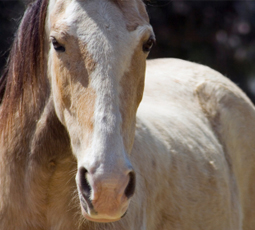
Q: I purchased my horse about a year ago, and he seemed to be perfectly healthy at the time. But over the winter, he was diagnosed with EPM. We treated him for two months, but he didn’t recover. He’s only 7 years old, and he has permanent nerve damage and can never be ridden again. What are the best ways to prevent EPM? Is there a vaccine for it?
Horses enter the picture as aberrant, or dead-end hosts. This means they can ingest the protozoa, but the protozoa cannot complete its lifecycle in the horse. When a horse ingests the sporocysts from pasture or feed contaminated with opossum droppings, for reasons yet understood, the sporocysts travel to the horse’s spinal cord, resulting in inflammation and damage that causes neurological deficits.
EPM can be a diagnostic challenge because the clinical signs vary from horse to horse depending on the location of the damage in the spinal cord and even the brain or brain stem can be affected. Many horses will present with a vague, minor neurological defect that may at first be thought to be a slight lameness. Other diagnostics include laboratory tests but results are not straightforward; blood tests can reveal antibody levels and other immunological assays, but there are false negatives and false positives, which don’t allow for a foolproof test.
Once a horse is diagnosed with EPM, there are a handful of various treatment options, but all options are lengthy, often given daily for about a month’s duration. The most commonly used treatment is ponazuril (Marquis), which is given orally once a day for 28 days. Other drugs to treat EPM include diclazuril (Protazil), nitrazoxanide, and a combination of trimethoprim-sulfa and pyrimethamine. In some cases, such as yours, the duration of medication may be extended beyond the one month period. Treatment is no guarantee that the horse will respond; recovery depends entirely on how badly the spinal cord has been damaged.
Prevention of EPM in this country is difficult, if not impossible due to the wide distribution of the protozoa; essentially EPM can be anywhere there are scavenging mammals such as opossums, raccoons, skunks, and cats. The basic and most common guideline for prevention is to keep these animals from entering the barn as best you can by keeping feed bins tightly sealed and other scavenger-enticing items such as trash and cat food out of the barn. Realistically, however, horses will be exposed to feces from these animals when out on pasture no matter what you do. Additionally, there is speculation that birds can also help transmit this parasite through their droppings.
In 2000, the pharmaceutical company Fort Dodge produced a vaccine for EPM. This vaccine was given a conditional license by the USDA, meaning the company had provided data supporting product purity, safety, and a reasonable expectation of efficacy and would use additional data gathered from the field to further explore the vaccine’s efficacy. Although the vaccine proved extremely safe, it did not significantly prove to reduce chances of infection and the conditional license was revoked; therefore the vaccine is no longer on the market. Currently, there are no other EPM vaccines on the market.
This may sound like a fairly bleak picture of the EPM situation for our horses, but it’s not all bad news. Clearly, much more research is required in this field and horse owners are very vocal about their concerns. There are other smaller start-up biologics companies that are researching the development of another EPM vaccine. Only time will tell if this will come to fruition.
— Anna O’Brien
Ask your questions on the horseillustrated.com Forums >>
See more Expert Q&As >>
Submit your Ask the Expert question >>






Great article with good information.
It’s nice to be informed about diseases horses can get. At least, we can watch for things.
good info
Very good info…My friend and I are taking care of an elderly couple’s horses for them, and one of them has EPM… This was a very helpful article, as we had been wanting to know how EPM was spred and contracted. Thank You!
Wow, it sure pays to be aware of these kinds of things. I want to keep my mare healthy.
At least, we in far northern Michigan to not have many possums, but we have enough skunks.
Very good article.
I strongly suggest that you vaccinate your horses against this disease. We recently had to put my friends horse down due to it and it was not a pretty site.
Great informational article though!
Such an awful debilitating disease. We have many opossums in our area and I hope they steer clear of my horse!
They can come near me however as I think they’re so cute.
This is a debilitating disease. Sadly lost our 12 yr old thoroughbred in April. Do hope to see a cure one day.